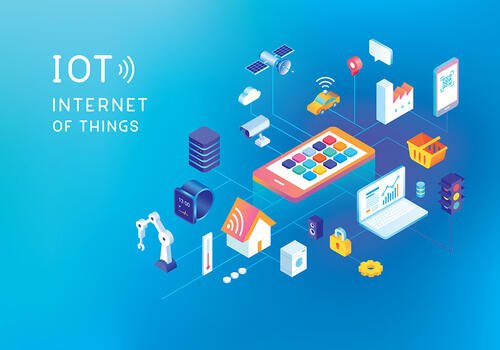SIZ Approved Course | Internet Of Things (IoT) | Lecture 02 | Components and sub-systems of IoT Architecture | Software & Examples Of IoT devices | IoT verticals | by @faizan2shiekh
Hello steemians, I hope you all are enjoying learning in this community. As you know, I am offering a course for this community, it is the second lecture of the course for the second week. My course was approved by @cryptokraze. The topics which I will be covering today are the following.
- Components of IoT Architecture
- Core sub-systems of IoT Architecture
- Examples Of IoT devices
- Softwares for IoT
- IoT verticals

source
Components of IoT Architecture
After introducing you to the basics in the previous lecture, now it's time to tell you about the components of IoT architecture. IoT devices are connected to the cloud and the end-user in a layered manner, all IoT devices are connected to the internet and IoT gateway using cellular networks. Though the data is sent to the cloud for analysis, in the intermediate layer an edge is implemented by the usage of microcontrollers to provide very fast responses. If cloud computation is used then there could be some latency issues and it is not cost-effective, that's why the idea of edge computing is more suitable.
There are a few basic components of an IoT architecture for proper implementation of it, they are as follows;
Microcontroller
A microcontroller is a compact form of computer to perform a specific task in an embedded system. A microcontroller generally includes a processor, memory(RAM), and I/O peripherals on a single chip. They are very cheap and single-task oriented in contrast to microprocessors.
Sensors
Sensors are devices that simply receive information from the surroundings and send it to the microcontroller for useful computation.
For Example, motion sensors, thermistors, etc.
Actutators
Actuators are devices that fire events to make changes in the environment.
For Example, LCD, servo motors.
Core Sub-systems of an IoT Architecture
There are a few sub-systems that form a complete IoT system. Each of them provides different functionality to the overall systems and produces the perfect combination for the IoT system to work.
Devices
This includes every device that participates in the overall operation to make the system work, they communicate with the cloud and have the ability to send and receive data from the cloud with utmost connectivity.
Cloud
A hub or cloud gateway service accepts the data from our devices and provides the required output to our actuators whenever needed.
Stream Processors
They consume data and integrate it with business processors and store the data into storage.
Storage
Storage can be divided into two paths;
- Warm path - data that requires immediate reporting and visualization form devices
- Cold path - data that does not require immediate response and stored for longer term for batch processing.
User Interface
This covers the front-end part of our system that provides the interaction on the client-end and allows the smooth usage of complex IoT systems to the user.
Software for IoT system
Now after understanding the architecture it's time to learn about the software that we will use to implement an IoT system.
We have three options to select the programming language for the development of our IoT system;
- C
- C++
- Rust
Both C and C++ are less secure and older than Rust, that's why it is preferred to use Rust.
- IoT Device - Rust programs running on bare metal
- IoT Gateway - LINUX along with kubernetes
- IoT Cloud - Rust will be used on the cloud paired with microservices
Example Of IoT devices
Let's consider the very basic device like a refrigerator, you may wonder that how it can be converted to an IoT device, there are two essential parts to make it an IoT device;
- Integration of a microcontroller in it
- Ensure the connectivity to the internet
Then this refrigerator can be equipped with sensors that can monitor different things like groceries in it, and it may order anything automatically to restock the groceries, this can help in reducing the human intervention for the trivial task.
source
IoT verticals
The term "vertical" in the context of the application refers to the usage of IoT for a very specific set of tasks. For example, using a computer for a specific purpose like a CCTV monitoring device. In the same way, IoT also has a few very specific verticals, a few of them are;
- Manufacturing
- Smart city
- Smart buildings
- Healthcare
- Energy
- Transportation and smart vehicles
- Logistics and inventory management
- Retail
- Agriculture
- Military
Conclusion
That's the end of the second-week lecture of my course, I hope to receive positive reviews from the community. Apart from it, I highly appreciate any correction in the above-shared data. Hope you all enjoyed learning. Thanks for reading my post!
Thanks to:
@cryptokraze
@siz-official
@vvarishayy
@arie.steem
@suboohi





Please write a short title of your post and make a justify your text because then your post is more valuable and attractive to see for everyone.
Thanks good post you make.
Regards, Faran Nabeel
Noted, I'll do it next time!
Congratulations you have been selected in the best picks.
Thanks! I will continue to produce quality content!